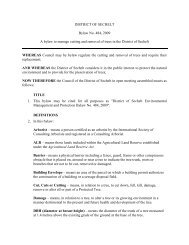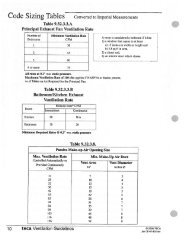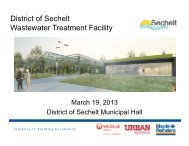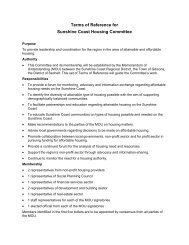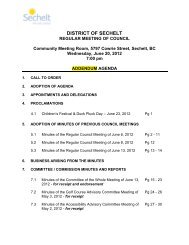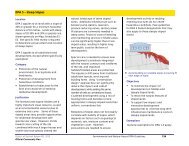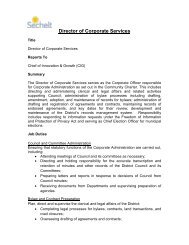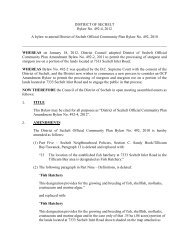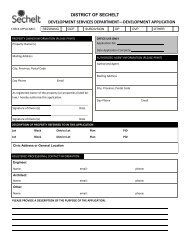District of Sechelt Urban Forest Plan
District of Sechelt Urban Forest Plan
District of Sechelt Urban Forest Plan
You also want an ePaper? Increase the reach of your titles
YUMPU automatically turns print PDFs into web optimized ePapers that Google loves.
<strong>District</strong> <strong>of</strong> <strong>Sechelt</strong> <strong>Urban</strong> <strong>Forest</strong> <strong>Plan</strong> 2010<br />
subdivisions less than three new lots; subdivision where the smallest lot being created is larger<br />
than two hectares, or the consolidation <strong>of</strong> existing parcels.<br />
Watercourse: Rights <strong>of</strong> way or dedication <strong>of</strong> land must be considered to preserve natural<br />
drainage courses, to ensure that drainage problems or environmental degradation does not<br />
occur as a result <strong>of</strong> subdivision. Statutory ROW width to be determined by the Approving<br />
Officer (pp 19-21).<br />
Part 10: Section G.<br />
Streetscaping specifies planting requirements, spacing, clearances, and species selection for<br />
street trees.<br />
Part 5. 33 Requires subdivision owners to plan, plant, and maintain trees for a period <strong>of</strong> two<br />
years from the date they are planted. A certificate <strong>of</strong> health must be provided after two years.<br />
All sick or dying trees must be replaced and maintained for another two years.<br />
Part 11 SC-5 Details a typical Tree Well.<br />
Tree Limbing/Cutting Policy 56 (overview):<br />
Purpose: To provide direction for district staff to deal with requests for trees to be removed or<br />
limbed. Removal may be approved for: safety reasons, damage to infrastructure, and view<br />
purposes.<br />
Where a tree cannot be removed, district may approve limbing for trees that provide wildlife<br />
habitat, aesthetically significant trees; larger species such as fir, arbutus, spruce and cedar, and<br />
in geographically significant areas where trees are necessary for stabilizing surrounding areas.<br />
Provincial Interaction with <strong>District</strong> <strong>of</strong> <strong>Sechelt</strong> <strong>Urban</strong> <strong>Forest</strong>s:<br />
Ministry <strong>of</strong> Agriculture and Lands- Land Program Services Branch (overview):<br />
Purpose: to identify the types <strong>of</strong> activities and purposes that Crown Land can be used for, and to<br />
provide direction on how to apply for the use <strong>of</strong> Crown land.<br />
How to apply for Crown Land: Applications are made through the Integrated Land Management<br />
Bureau, otherwise known as Front Counter BC. Front Counter BC administers, allocates,<br />
adjudicates, documents and manages Crown land tenures for a number <strong>of</strong> land programs. The<br />
most applicable land program for the <strong>District</strong> <strong>of</strong> <strong>Sechelt</strong> is the Community and Institutional Use.<br />
Community Institutional Land Use Sponsored Crown Grants (SCG) and Nominal<br />
Rent Tenures (overview):<br />
Purpose: The Community and Institutional Program Policy serves to support the community,<br />
social and economic goals <strong>of</strong> the Province <strong>of</strong> British Columbia by making parcels <strong>of</strong> Crown land<br />
available for community and institutional uses. It enables the use and disposition <strong>of</strong> Crown land<br />
for health, education, public safety, community infrastructure, and public facilities that benefit<br />
the public-at-large.<br />
Municipalities are eligible to apply for SCGs and NRTs in accordance with the Land Act and<br />
operational policies.<br />
56 <strong>District</strong> <strong>of</strong> <strong>Sechelt</strong>. 2009b. Tree Limbing and Cutting Policy.<br />
November 2010 Page 49





